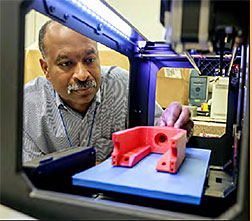- Number 426 |
- November 10, 2014
A PPPL first: A 3D printed mirror for microwave launchers

Bob Ellis with a 3D-printed plastic prototype
for a non-mirror part of the launcher.
(Photo credit: Elle Starkman/PPPL)
When scientists at the Korea Supercomputing Tokamak Advanced Research (KSTAR) facility needed a crucial new component, they turned to engineer Bob Ellis of DOE's Princeton Plasma Physics Laboratory. His task: Design a water-cooled fixed mirror that can withstand high heat loads for up to 300 seconds while directing microwaves beamed from launchers to heat the plasma that fuels fusion reactions.
Ellis, who had designed mirrors without coolant for shorter experiments, decided to try out a novel manufacturing process called 3D printing that produces components as unified wholes with minimal need for further processing. 3D printing would enable the mirror to be built for less cost than a non-water-cooled mirror produced by conventional manufacturing, Ellis said, “and that was a very nice thing to find out about.”
The project marked a first for PPPL, which had previously used 3D printers to build plastic models but had not employed the process for creating metal parts. “Metal came into 3D printing about five years ago and was sort of exotic then,” said Phil Heitzenroeder, who heads the Mechanical Engineering Division at PPPL. “Now 3D is beginning to drift down into real-world metal products.”
Ellis created a CAD-CAM model of the shoebox-size mirror system and delivered it to Imperial Machine & Tool Co. to produce the stainless steel and copper component through metal 3D printing. The process puts down hair-thin layers of stainless steel powder and fuses the powder in each layer with lasers. The parts are thus built from the bottom up layer by layer — another name for 3D printing is “additive manufacturing” — and follow every twist and turn of the CAD-CAM design.
The stainless steel granules have the consistency of talcum powder before they are fused, said Christian M. Joest, president of the 70-year-old Columbia, N.J., machining and fabricating company. The 3D process took about 20 hours to complete, Joest said.
The process proved ideal for the water-cooled mirror, which PPPL shipped to KSTAR in early October. The part consists of a thin sheet of polished copper mounted atop a stainless steel base, with serpentine channels for water winding through the base’s center. Conventional construction could have required the base to be built in multiple pieces so that the channels could be drilled, with the pieces then welded back together. “3D printing allows you to produce components in a single piece,” Ellis said, “and that’s a huge advantage.”
Ellis now is designing a steerable mirror for KSTAR that can be controlled by computer to direct microwaves into different parts of the plasma. Ellis dubs this mirror, to be delivered next year, “Generation 2.0,” since it will have flat cooling channels rather than the round ones on the fixed mirror. The flat channels will increase the efficiency of the coolant, he said, which will be important for shedding heat from the constantly moving steerable mirror.[John Greenwald, 609.243.2672,
jgreenwa@pppl.gov]
